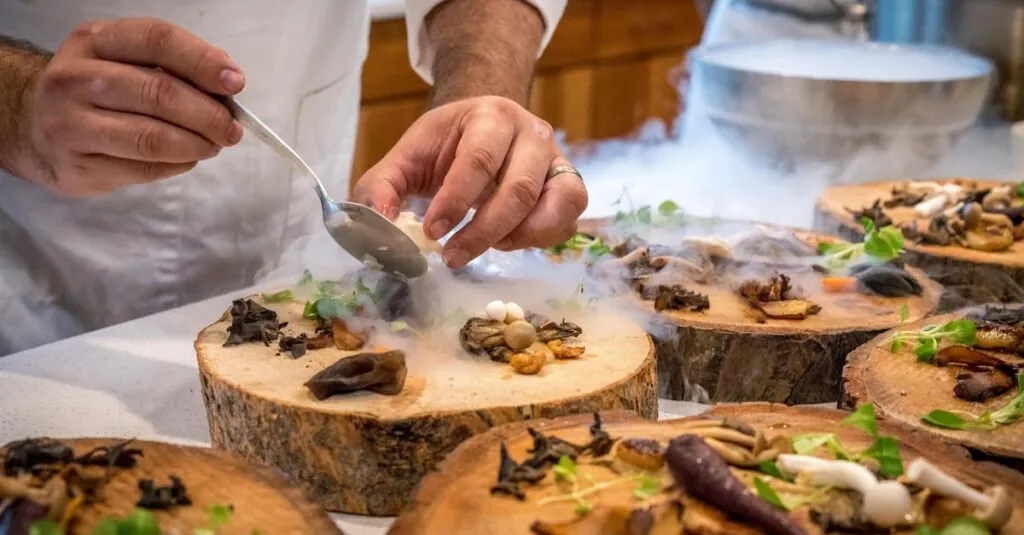In the world of culinary arts, a dash of creativity and a pinch of technique can transform a simple dish into a gastronomic masterpiece. But how do chefs truly measure their prowess in the kitchen? Enter culinary technique rating, the secret sauce that helps both budding cooks and seasoned chefs alike elevate their skills. It’s like a Michelin star for your frying pan—no pressure, right?
Table of Contents
ToggleUnderstanding Culinary Technique Rating
Culinary technique rating serves as a critical benchmark in the culinary world. Chefs use this rating to assess their skills and improve their craft.
Definition of Culinary Technique Rating
Culinary technique rating evaluates the proficiency of cooking methods. This system considers various factors, including precision, creativity, and execution. Ratings can reflect a chef’s ability to utilize techniques, such as braising, sautéing, and baking. Assessment criteria often include flavor development, presentation, and ingredient quality. By categorizing techniques, this rating streamlines the learning process for chefs at different skill levels.
Importance of Culinary Technique Rating
Culinary technique rating plays a pivotal role in skill enhancement. It provides a structured approach for chefs to identify strengths and weaknesses. Chefs can prioritize specific techniques to master, thereby advancing their overall culinary repertoire. A clear rating system motivates chefs to experiment and innovate. This motivation fosters creativity, leading to artistry in dishes. Moreover, culinary technique ratings help consumers gauge restaurant quality, similar to Michelin stars.
Categories of Culinary Techniques
Culinary techniques fall into distinct categories, addressing various aspects of cooking that contribute to skill enhancement. Two major categories include cooking methods and presentation skills.
Cooking Methods
Cooking methods encompass diverse techniques that significantly affect meal preparation outcomes. These methods include sautéing, baking, grilling, steaming, and frying among others. Each technique has unique characteristics that influence flavor, texture, and appearance. Mastery of these methods enhances a chef’s proficiency, enabling them to create dishes that are not only delicious but also visually appealing. Precision in temperature control and timing plays a crucial role in executing these methods effectively. Chefs can elevate their culinary repertoire by focusing on these foundational techniques, allowing for greater creativity and experimentation in their cooking.
Presentation Skills
Presentation skills involve the artistic arrangement of dishes to enhance visual appeal. Techniques in this category include plating, garnishing, and color coordination. Effective presentation captures diners’ attention and elevates the dining experience, making it more enjoyable. Understanding the importance of color contrasts and textures in plating contributes to the overall aesthetic. Chefs can utilize unique serving vessels to further augment their dishes. Prioritizing these skills fosters creativity and draws diners into the culinary experience, showcasing the chef’s artistry while complementing the flavors of the meal.
Factors Influencing Ratings
Culinary technique ratings depend on various elements that evaluate a chef’s capabilities and experience. Notably, the skill level of the chef significantly impacts ratings.
Skill Level of the Chef
Expertise in culinary techniques varies among chefs. Advanced chefs often demonstrate greater precision in cooking methods. Mastery of techniques enhances the ability to create unique flavors and textures. Assessment of a chef’s skill level may include experience, formal training, and ability to innovate. Evaluators will consider how well the chef adapts traditional techniques to modern cuisine. Overall, higher skill levels correlate with more favorable ratings.
Quality of Ingredients
Ingredients play a crucial role in determining culinary ratings. Fresh, high-quality ingredients often yield superior dishes. Chefs who prioritize sourcing local, seasonal products often enhance dish flavor and presentation. Evaluators recognize the importance of ingredient quality in achieving desired taste profiles. Sustainable and ethically sourced ingredients can further elevate a chef’s rating. Ultimately, the combination of skilled execution and top-quality ingredients leads to exceptional culinary creations.
The Rating Process
The rating process evaluates chefs’ proficiency in culinary techniques, considering various factors that contribute to skill mastery. This structured approach fosters growth in both novice and experienced chefs.
Evaluation Criteria
Assessment focuses on several key criteria in culinary technique rating. Precision emerges as crucial since accurate execution influences the dish’s overall quality. Creativity ranks high, as innovative approaches elevate standard dishes. Execution of each technique further influences the rating; consistency in technique yields better results. Many ratings also consider ingredient quality. Fresh, high-quality ingredients enhance flavor and presentation, impacting the overall score. By addressing these criteria, chefs can gain valuable insights into their abilities and improvement areas.
Rating Scales Used
Various rating scales gauge culinary techniques comprehensively. Some scales utilize a numerical system, allowing ratings from 1 to 10, with higher scores indicating superior skill levels. Others adopt a categorical approach, such as a letter grading system or qualitative descriptors like “exceptional,” “good,” or “basic.” A visual scoring method, employing stars or forks, ranks chefs based on their proficiency. These scales provide clear distinctions, making it easier for chefs and consumers to understand culinary quality. By employing these varied rating scales, culinary experts create an effective benchmark for skill evaluation.
Culinary technique rating stands as a vital tool in the culinary world. It not only helps chefs refine their skills but also elevates the dining experience for consumers. By focusing on both cooking methods and presentation skills, chefs can enhance their craft and creativity.
The structured evaluation process encourages continuous improvement and innovation. As chefs strive for higher ratings, they ultimately contribute to a richer culinary landscape. This rating system fosters a deeper appreciation for the artistry involved in cooking and ensures that quality remains a priority in the industry. Embracing culinary technique ratings can lead to remarkable transformations in both dishes and dining experiences.





